From Trash to Treasure: Liebenberg Uses Design for Repurposing to Spark Student Interest in Online Classes, Possibly Making a Difference in the COVID-19 Pandemic
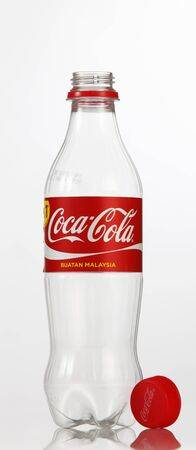
May 6, 2020
Can a Coca-Cola bottle be repurposed to make a medical device? What about a plastic bag? How effective are the masks we must now wear when in public? How can masks be reused safely? What are some low-cost solutions for the shortage of ventilators? Leon Liebenberg, a Teaching Associate Professor in Mechanical Science and Engineering (MechSE) was hopeful that students in his ME 270 course might answer some of these questions, even possibly resolve some of the COVID-19-related issues our society is now facing. Liebenberg says, “With everything being turned upside down” (due to the pandemic), he sought a way to help his students more fully engage in online learning. So over spring break, he revamped the final project for his Design for Manufacturability course, making it timely, extremely relevant to the real world, and sure to pique the interest of his students, whom he says are passionate about making a difference. As part of ME270’s “Design-for-Repurposing” final project, students were to design a prototype for emergency medical equipment, such as a ventilator or face mask, using repurposed materials and products.
Did Liebenberg’s students respond as he had hoped? To his delight, they did. He reports that his students were “very excited about this project, as they understand the huge demand for emergency medical equipment in especially third world countries that might not have access to modern machinery like 3D printers.”
“My main goal was to continue engaging the students in a meaningful manner,” says Liebenberg about his revised pedagogy. For instance, before COVID-19, it had been business as usual: he’d stood at the front of the class, lecturing his students about manufacturing design; his five TAs had been around to help students in the laboratories. “Suddenly, the rug has been pulled out from under us, and that physical connection is gone,” Liebenberg laments. “So during spring break, I thought so hard, ‘What can I do from my side to better engage the students, to give them the feeling that they can use the stuff that they're learning in their subject Design for Manufacturability, but in a way that connects maybe to what they're doing now?’ He says literally the Saturday before Monday classes were to reconvene online after spring break, he said to himself, “What about COVID-19? A design for emergency medical equipment?”
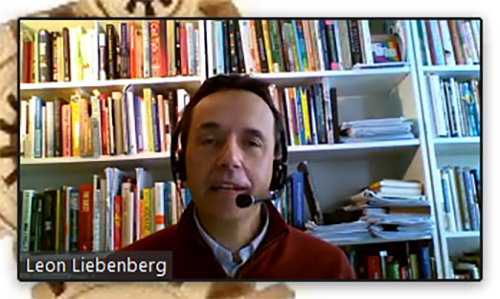 MechSE's Leon Liebenberg teaching his ME270 course via Zoom.
MechSE's Leon Liebenberg teaching his ME270 course via Zoom.“This is the challenge,” he says, encapsulating the various goals he tried to incorporate into the project. “See what you can come up with. Look at what other people around the world have done. Come do something unique and novel. Now make it meaningful. Make it connected to the society in which we're living and the syllabus.”
Regarding how he expected his students to come up with a project, he suggested using creativity fueled by research. “I want you to come up with ideas,” he said. “It's an exercise in idea creation.” To begin with, he recommended that they get their creative juices flowing by researching to see what others have done…by reading up about how face masks actually keep viruses out or by looking at how mechanical ventilators work.
Of course, a key component of the project was that this piece of medical equipment be “manufacturable” anywhere in the world…not just America, where, according to Liebenberg, manufacturers have got “the most beautiful machines to manufacture…literally factory lines of new 3D printers.” However, he wanted his students to consider: “But what about India? What about Africa? People might not have 3D printers, and people get the COVID-19 virus, and they need to be on respirators. How do you do that? Do you just let the people die, or is this something else that we can do as first-world engineers?”
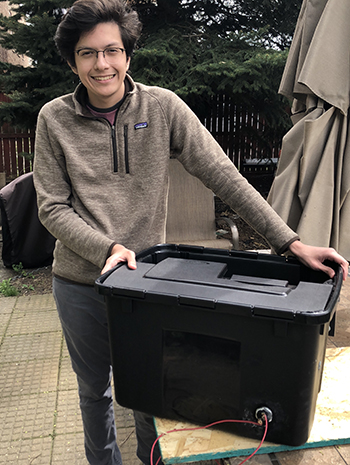 MechSE freshman Fabrizzio Vega and his Steam Box Disinfector, useful for disinfecting various items, such as face masks, for reuse. (Photo courtesy of Fabrizzio Vega.)
MechSE freshman Fabrizzio Vega and his Steam Box Disinfector, useful for disinfecting various items, such as face masks, for reuse. (Photo courtesy of Fabrizzio Vega.)So his idea was to repurpose common materials that might be readily available in third-world countries. “So my challenge to the students,” Liebenberg explains, “was: ‘Look around you! What common materials can you find? Like a Coca-Cola bottle, like a plastic bag. How can you repurpose that common material which might be available in Africa?'” (According to Liebenberg, Coca-Cola “just happens to be the most widely used beverage in the world,” so Coca-Cola bottles are readily available in Africa.) His challenge to students was to think of products that can be repurposed in a medical manner so that people in India or in Africa, who might have access to these materials, can come up with and build their own ventilator and maintain it, rather than the usual scenario—folks from first-world countries essentially “dumping a high-technology artifact in the third world and saying, ‘There you go.’”
Another of Liebenberg’s goals via the project was to foster engineering empathy—a fairly new idea in the engineering education front. Thus, he encouraged his students to put themselves in someone else’s shoes. “It's a totally different mindset. It's a different culture,” he challenged his students: “You have the manufacturing knowledge…you know a lot about material properties. Can you combine all of that and try to empathize with a person in the third world? Put yourself in the shoes of a medical doctor running a clinic in Malawi.” He further describes the scenario, explaining that there’s no electricity, just a diesel generator. “How the heck is that person going to deal with COVID-19? Say she's got a rush of 20 patients who need ventilators; how are you going to do that?”
Liebenberg also hoped to empower his students, telling them, “Listen, you are student-engineers. You might only be second-year students, but you've got the requisite skills; you've got knowledge; and you are all brilliant. You all know how to think out of the box.”
A final goal of Liebenberg’s was to prepare his students for the reality of life as an engineer facing a real-world problem. To do that, he hoped to make them “uncomfortable,” make them feel that they’re really in an emergency situation and help them grasp that this is often an engineer’s role.
“My goal was to get students uncomfortable, to show them that we’re living in a real world where there are viruses and other existential uncomfortabilities. Because in two years’ time, when they're professional engineers, this is exactly the kind of thing that they're going to have to contend with. ‘So this is not a simulation. This is it. Get into it. Get used to it!’”
Liebenberg and his cadre of TAs and a lab instructor were quite impressed with some of the designs the ME270 students came up with, which ranged from ventilators, to face masks, to steam disinfectors.
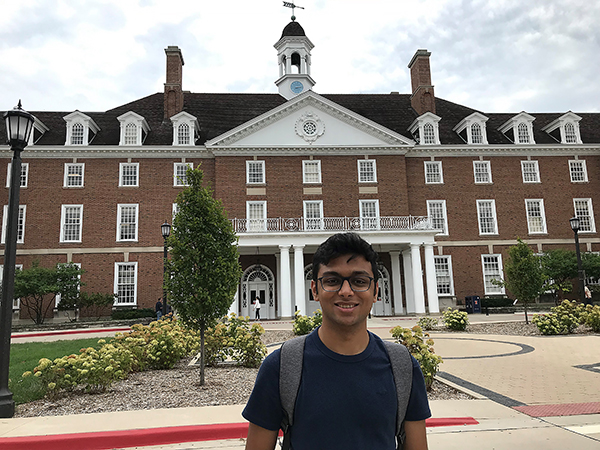
Armaan Mehta on campus in front of the Illini Union. (Photo courtesy of Armaan Mehta.)
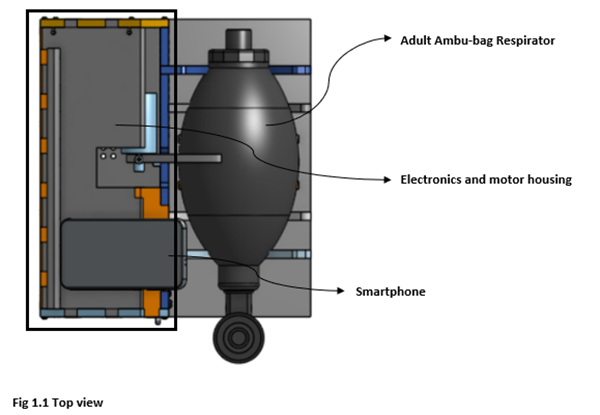 CAD drawing of Armaan Mehta's Repurposed Laser-Cut BVM Ventilator. (Photo taken from student's final project website.)
CAD drawing of Armaan Mehta's Repurposed Laser-Cut BVM Ventilator. (Photo taken from student's final project website.)For example, MechSE freshman Armaan Mehta designed a Repurposed Laser-Cut BVM (Ball Valve Mask) Ventilator, voted #1 by his peers, instructors, and visiting professors during the course's May 5th final presentation on Zoom. (He also received a gold award worth an additional 1.5% to be added to his final grade.)
So how does Mehta’s ventilator work? First, he repurposed a BVM (a hand-held device pumped manually to supply artificial breathing to patients not breathing properly or at all). His design “automates the ‘squeezing’ to a precise pressure and flow, regulating the timing and size of breaths,” he explains. He also repurposed items regularly found in a household: a 12-volt DC motor found in a power drill, a smartphone, and plywood. (Note: he avoided using 3D-printed components. In addition to Liebenberg's caveat that third-world scenarios might not have 3D printers available, Mehta says they “take extremely long to manufacture and will further not be easy to clean due to the grooves on each layer.”) Designed to be entirely laser cut, his prototype can be manufactured and assembled in under two hours. Plus, “it’s optimized for flat-pack packaging, meets NHS guidelines, and includes failsafe alarms with an optional backup battery.”
He also produced a cheaper, more advanced device by repurposing a mobile phone as a display and utilized a wireless microcontroller to monitor and configure the optional vitals monitoring sensors included. These can be fed to the healthcare worker via a smartphone or central monitoring system, thus allowing social distancing between the patient and worker.
Mehta’s ventilator is also inexpensive to make. According to his research, before the pandemic, ventilators cost $20–25k, but due to extreme demand and increasing shortages, now cost around $45,000. He says India may need a million more ventilators, at a cost of around $45 billion (450% of its entire medical budget). However, Mehta calls his design “unbelievably cheap to build” claiming it can be easily produced for under $100 per machine.
For Mehta, the most challenging part of this project was “procuring enough medical knowledge and meeting the appropriate NHS/medical guidelines, while utilizing DFA (Design for Assembly) and DFM (Design for Manufacturing) guidelines taught in lectures to design the best possible prototype.” He also sought to meet or exceed the capabilities of other designs through design thinking…no small feat. Another challenge? “To quickly design the prototype using CAD given that I had limited access to a workstation or familiar software which I normally would use in the MEL.”
What he found most rewarding about the project was being able “to utilize and hone the skills and knowledge I developed from lectures, labs, and mini projects one through seven to creatively repurpose a product and develop a mechanical solution to a real-world problem.” Another challenge was “considering environmental sustainability, heavily emphasized in this class,” he acknowledges. “This provided a much deeper insight to the design process considering what we learned in class.” (He also calls receiving the gold award “undeniably incentivising and rewarding as well.”)
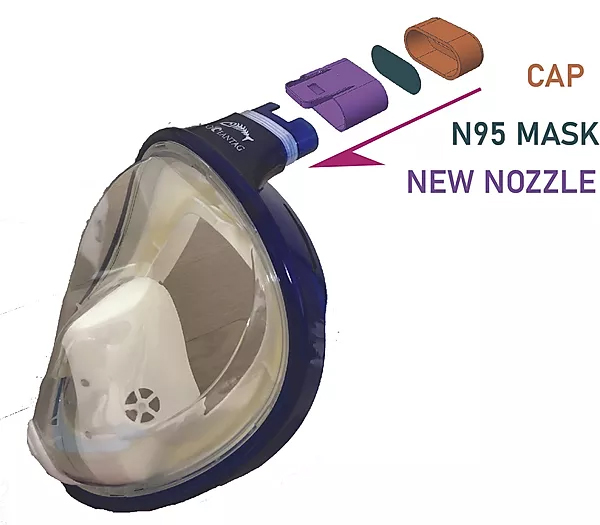 A CAD design of Daewon Hong’s repurposed diving mask. (Photo taken from student's final project website.)
A CAD design of Daewon Hong’s repurposed diving mask. (Photo taken from student's final project website.)However, for Mehta, his ventilator has been more than just an assignment; he hopes to continue working on it to perfect it. (Then share it for use by medical workers?) He admits: “I am also looking to form a team of motivated students who are willing to contribute to the design and would like to bring the design to life over the summer. If you would like to contribute, please contact me at armaanm3@illinois.edu.”
Another ME270 student, Daewon Hong, redesigned a face mask for his project. He enumerates some of the issues with conventional face masks used by the public (issues we have all been discovering while wearing them). For instance, achieving a perfect seal is nearly impossible, giving the virus an entry point. Furthermore, because conventional face masks often cause one’s glasses to fog up, the user must constantly adjust the face mask, ultimately touching his or her face.
Hong resolved these issues by repurposing a scuba diving mask, which completely encloses a person’s face. “A scuba diving mask is very useful in combating this global pandemic due to the fact that it can ensure that there is only one entry point between the respiratory system and the surrounding environment,” Hong states. “This project will revolve around building a safer and more effective face mask focused on protecting the user.”
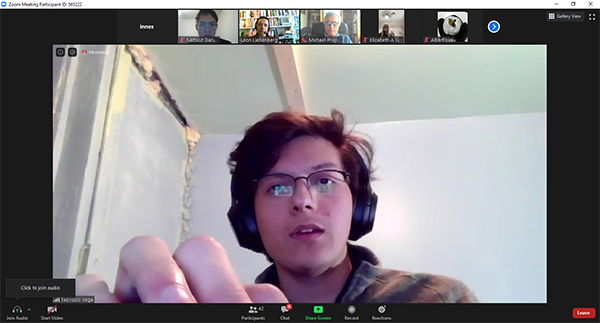 Fabrizzio Vega presenting his design concept on ME270's May 5th final presentation zoom session.
Fabrizzio Vega presenting his design concept on ME270's May 5th final presentation zoom session.Another ME270 student, Fabrizzio Vega, a freshman in Mechanical Engineering, designed an easy-to-build steamer useful for disinfecting various items for reuse. It uses an adapted heating element from an electric water boiler to produce the steam needed (see his detailed steps showing how to build one).
According to Vega, the most challenging part of the project was coming up with a prototype that was effective yet easy to build.
“I had to make many choices, such as how I would heat the water and whether to produce the steam in a different container, while keeping the user in mind.”
What did Vega find to be the most rewarding thing about working on this project? “The joy I felt after seeing my final prototype work,” he admits.
Vega reports applying many concepts learned in Design for Manufacturability when working on his project: “So I would like to thank Professor Liebenberg for an amazing semester of Design for Manufacturability.”
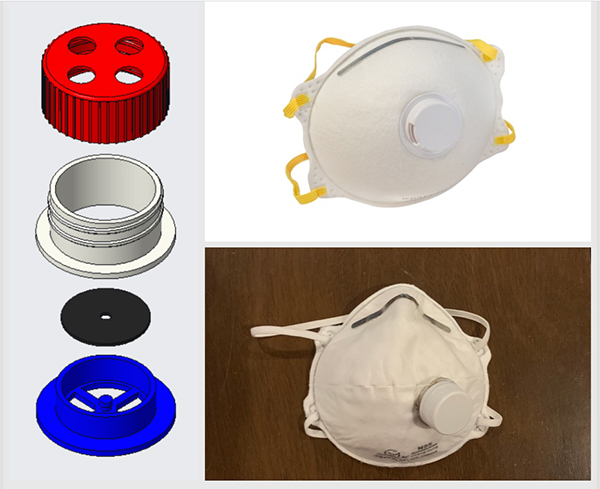 Matt Grendzinski's CAD drawings (left and top right) and actual prototype (bottom right) of a repurpsoed exhalation valve for a face mask. (Photo taken from student's final project website.)
Matt Grendzinski's CAD drawings (left and top right) and actual prototype (bottom right) of a repurpsoed exhalation valve for a face mask. (Photo taken from student's final project website.)And remember Liebenberg's offhand suggestion that one of his students repurpose the ubiquitous Coke bottle? One student, Matt Grendzinski, actually took him up on the challenge. He designed a Repurposed Exhalation Valve for a face mask from an empty pop bottle. (However, his wasn't actually a Coke bottle; the cap on his prototype [to the bottom right] wasn't red!)
So what was Liebenberg’s take on the overall impact of the project? How does he feel his students responded? The professor reports that they were extremely engaged. “I'm really glad to say that the students are super excited about this project—super excited!”
For instance, Grendzinski, who designed the Repurposed Exhalation Valve from a pop bottle, was quite excited about designing a product that might help people. “After having the semester turned upside down by the coronavirus,” he says, “it was extremely rewarding to be able to work on a project that could actually make a difference in the world.”
Grendzinski acknowledges that when he first began his project, he was doubtful: “I honestly did not think that I could come up with a product that would actually be useful or practical. However, as I conducted research, I quickly realized how dire the situation is, and therefore how many design opportunities there are. Because the coronavirus is such an unprecedented event on a global scale, it poses many problems that engineers have never had to deal with.” Recognizing that the demand for facemasks, both for doctors and civilians, has never been higher, but that factories are just not meeting the demand, he continues, “I realized how simple the actual mechanism of an exhalation valve is, and that it really can be created so easily. I gained more and more confidence in my design as I progressed in the project.”
 .Matt Grindzinski at work on his repurposed valve design. (Photo taken from student's final project website.)
.Matt Grindzinski at work on his repurposed valve design. (Photo taken from student's final project website.)However, completing the design for his repurposed valve was not without its challenges. Grendzinski would agree with Liebenberg’s “the-rug-has-been-pulled-out-from-under-us” assessment regarding the shift from campus-centered to online classes due to COVID-19. He concedes, “This project did pose many challenges. First and foremost, it was an extreme challenge just adapting to online learning. I did not have the usual resources offered by the Innovation Studio, so I had to improvise and use whatever I could find at home. It was disappointing not being able to fully flesh out my idea with 3D printed prototypes, but the CAD modelling was satisfying, nonetheless.”
He reports that another challenge was parsing through the “limited and ever-changing information about the coronavirus. While there is plenty of literature about exhalation valves, the information about manufacturing facilities was always changing.”
Despite some of the logistics challenges, Grendzinski found working on a brand new challenge of such global impact to be extremely rewarding. “In this project I learned how many design opportunities arise from big challenges,” he admits. “When a new problem pops up, it is a great chance to act fast and work to solve it first. The more interesting challenges are the ones that are totally new.” Plus, he relished working on a real-world project capable of having such a huge impact on lives. “I also learned how rewarding it feels to work on a project that is relevant to your life and that can make a significant difference on people’s lives. Overall, I thoroughly enjoyed this challenge.”
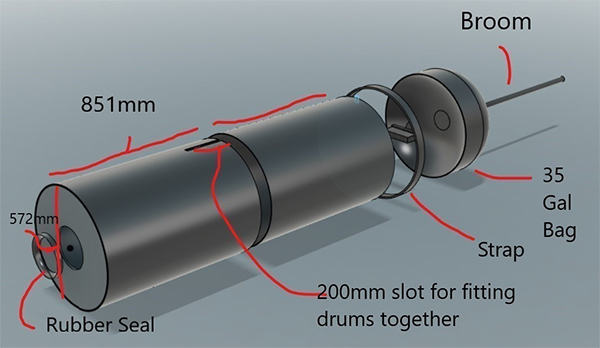 Sky Nunez's "Iron Lung" Ventilator. (Photo courtesy of Sky Nuñez.)
Sky Nunez's "Iron Lung" Ventilator. (Photo courtesy of Sky Nuñez.) Another ME270 student, MechSE senior Sky Nuñez, designed a respirator based on the pump system Iron Lungs use. Nuñez reports that his respirator operates by effectively altering the volume of the tank to create a cycle of negative and positive pressure in the tank which assists in breathing. “To maintain these desired pressures,” he claims, “the sealing of the tank and size of volume change are critical.”
For this project, Nuñez set out to design something that can function in places where there are no power and/or running water, and pressurized oxygen lines are unavailable.
“It was very challenging to research,” he admits, “as there is an immense quantity of information to sift through. Eventually my curiosity led me to look into what they did to satisfy ventilator needs in historic pandemics, which led me to the Iron Lung usage in the Polio Epidemic.”
 Sky Nuñez. (Photo courtesy of Sky Nuñez.)
Sky Nuñez. (Photo courtesy of Sky Nuñez.)Nuñez indicates that this project, along with others in this class, inspired him to study older devices and their unique designs. “I have always found them intriguing,” he says, and admits that he was unable to resist collecting a few on his thrift store excursions. “Everything these days aims for plastics and tiny circuits to solve all our problems,” he insists, “However, there are some truly clever designs in these old devices still just as worthy today.” In fact, he finds it quite astonishing to discover that “sheetmetal calculators from West Germany, selenium-powered light detectors, and wind-up video cameras with wooden gears, all without electronics of any kind, still function some 70 years after their creation. There must be something to them worth knowing as a designer.”
So does Liebenberg believe any of his students actually came up with viable tools that can make a difference during the pandemic? Acknowledging that it's a bit too early to say, he reports, “There are some ideas that are really, really creative,” then adds, “Historically speaking, if I look at what students have done in my previous courses, I am positive that someone's going to come up with a game changer. I am positive about that.”
Story by Elizabeth Innes, Communications Specialist, I-STEM Education Initiative. Photographs by Elizabeth Innes unless otherwise noted.
Other I-STEM articles about playful pedagogy:
- Via ENGINE, a Group of Illinois Educators Promote Using Playful Pedagogies to Engage Students
- Liebenberg’s ME 270 End-of-Semester Main Project Presentations Showcase Students’ Manufacturability Redesigns
- ME370’s Final Competition—March of the Automata—Fosters MechSE Students’ Creativity, Perseverance, and Teamwork
More: Faculty Feature, MechSE, 2020

Zoom screen shot of Armaan Mehta presenting his design during the May 5th final presentation event.













.jpg)
















